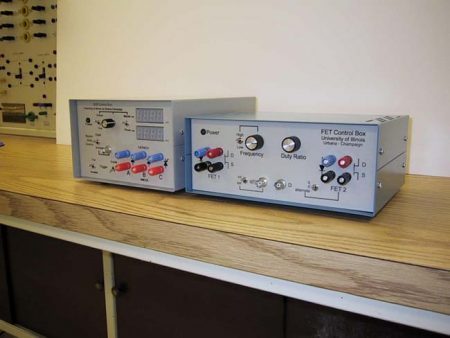
Over the two summers of 2002 and 2003, the equipment used in ECE469, Power Electronics Laboratory, was upgraded. The first project was to replace the existing FET boxes. The old boxes contained one FET and one diode with uncommitted power terminals. The new box contains two of each. Flexible controls allow each FET to be switched in one of three ways to realize a variety of dc-dc, dc-ac, and ac-ac converter topologies including synchronous rectification. The second project was to replace the existing SCR boxes. Each box contains three SCRs with uncommitted power terminals. The phase-control algorithm used is adaptable to a range of frequencies and power sources. The new FET boxes were rolled out for the Fall ’02 semester, then upgraded for Fall ’03, while the SCR boxes were rolled out for the Fall ’03 semester. Additional projects included a simple analog PWM amplifier, used as a demonstration since Fall ’03, and a simple brushless dc (BLDC) drive/dynamometer set for ECE431, Electric Machinery, rolled out in Spring ’04.
Often, lab equipment is treated as a “black box”, meaning that all the student knows is the terminal characteristics. For these projects, we followed a “blue box” philosophy. As much as possible, the timing and gate drive circuits critical to box operation are explained to the students. Our goal is to teach students not only how to construct a power circuit, but also how to construct a complete circuit, including the control portion. This requires conceptual simplicity. For example, the FET box uses a standard PWM chip for gate waveform generation, and the SCR box uses simple digital logic for timing. However, lab equipment must also be compact, robust, and maintainable. For the SCR box in particular, these criteria led to an integrated implementation using a microcontroller and CPLD. The circuit was first built using discrete logic chips and then implemented in the CPLD. If we had used discrete logic, the circuit board would have been twice the size and much less flexible. Despite the integration, conceptual simplicity is maintained, so that both boxes can be explained at a high level with ECE469 students.
This work was supported primarily by the Grainger Center for Electric Machinery and Electromechanics (CEME) and the Department of Electrical and Computer Engineering (ECE). It was performed under the direction of Prof. Philip T. Krein, who developed the original boxes that were replaced, and in consultation with Prof. Patrick L. Chapman, the ECE469 instructor for Fall ’03 and ECE431 instructor for Spring ’04.